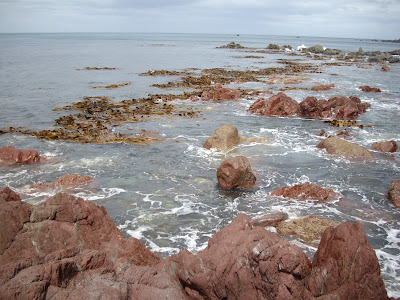Well, for some reason our internet server has slowed to a crawl for the past couple of weeks, making it essentially impossible to post pictures (a mercy, perhaps). As we are now fully settled into work, we've opted to take a couple of weekends to explore our near environs. Saturday was supposed to be the pick of the weekend days. As NZ weather forecasts are little better than educated guesses, we shouldn't have been surprised when we awoke to an overcast, windy day.
By the time noon rolled around, we figured it wasn't going to clear, but decided to head up to the karori reserve for a look around anyway. Amazingly, it's a 7 minute bus ride from our front door up to the forested hills that comprise this unique urban bird sanctuary. While it is not exceptionally scenic when compared to "pristine" bush, it does provide a protected space for rare (and not so rare) birds to breed, nest and feed. As a result, the tui, bellbird and other "natives" are almost as familiar to Wellingtonians as pigeons, house sparrows and blackbirds (remember, there are no squirrels here). Also, the tuatara-a rare prehistoric lizard--was discovered at karori a few years ago, and are now bred here. You'll have to trust me when I say we saw one; either that, or I'll e-mail you the pic.
After karori, we elected to take the "scenic" route home, which took us for several miles up a steep ridge overlooking the city, and ultimately to the wind turbine perched above the Brooklyn neighborhood (fuhgeddaboudit). Fun fact: NZ is actually on track to provide 80% of its energy from domestic renewable sources by 2025. On the looooong way up, we saw a tree weta--which is an insect about the size of a man's middle finger--devouring a juicy spider (also not pictured). Also seen were a few very intrepid mountain bikers and some truly insane runners. On the way down, a herd of elephants could have strolled by and we wouldn't have cared, we were so exhausted.
For some strange reason, we went to the gym the next (gloriously sunny) day. It is located in a converted loft space, with several large windows and a juliet balcony overlooking Lambton Quay, down which the Santa's Day parade marched, an eclectic and culturally diverse celebration of the things we all associate with Christmas-- beach weather, long days, bollywood movies and Scottish marching bands.


